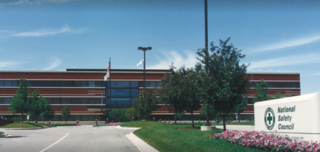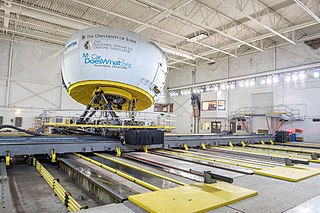
Automotive safety is the study and practice of design, construction, equipment and regulation to minimize the occurrence and consequences of traffic collisions involving motor vehicles. Road traffic safety more broadly includes roadway design.

Road traffic safety refers to the methods and measures used to prevent road users from being killed or seriously injured. Typical road users include pedestrians, cyclists, motorists, vehicle passengers, horse riders, and passengers of on-road public transport.
Construction site safety is an aspect of construction-related activities concerned with protecting construction site workers and others from death, injury, disease or other health-related risks. Construction is an often hazardous, predominantly land-based activity where site workers may be exposed to various risks, some of which remain unrecognized. Site risks can include working at height, moving machinery and materials, power tools and electrical equipment, hazardous substances, plus the effects of excessive noise, dust and vibration. The leading causes of construction site fatalities are falls, electrocutions, crush injuries, and caught-between injuries.

Defensive driving describes the practice of anticipating dangerous situations, despite adverse conditions or the mistakes of others when operating a motor vehicle. It can be achieved by adhering to general guidelines, such as keeping a two- or three-second gap between the driver's vehicle and the vehicle in front to ensure adequate space to stop. It is a form of training for drivers that goes beyond road rules and the basic mechanics of driving techniques. Defensive driving reduces the risk of collisions and improves road safety.
The National Highway Traffic Safety Administration is an agency of the U.S. federal government, part of the Department of Transportation. It describes its mission as "Save lives, prevent injuries, reduce vehicle-related crashes" related to transportation safety in the United States.

The National Safety Council (NSC) is a 501(c)(3) nonprofit, public service organization promoting health and safety in the United States. Headquartered in Itasca, Illinois, NSC is a member organization, founded in 1913 and granted a congressional charter in 1953. Members include more than 55,000 businesses, labor organizations, schools, public agencies, private groups and individuals.

The National Advanced Driving Simulator (NADS) at the University of Iowa College of Engineering is among the largest ground vehicle driving simulator in the world along with Toyota's driving simulator at Higashifuji Technical Center.
Make Roads Safe is a global road safety campaign established with the aim of securing political commitment for road traffic injury prevention around the world.
The Global Environmental and Occupational Health e-Library or GeoLibrary is a database of occupational safety and health and environmental health training materials and practice tools. The library is divided into three sections: Environmental Health; Occupational Health and Safety; and a specialty library on Road Safety at Work.
Prevention through design (PtD), also called safety by design usually in Europe, is the concept of applying methods to minimize occupational hazards early in the design process, with an emphasis on optimizing employee health and safety throughout the life cycle of materials and processes. It is a concept and movement that encourages construction or product designers to "design out" health and safety risks during design development. The concept supports the view that along with quality, programme and cost; safety is determined during the design stage. It increases the cost-effectiveness of enhancements to occupational safety and health.

A traffic collision, also called a motor vehicle collision, car accident or car crash, occurs when a vehicle collides with another vehicle, pedestrian, animal, road debris, or other stationary obstruction, such as a tree, pole or building. Traffic collisions often result in injury, disability, death, and property damage as well as financial costs to both society and the individuals involved. Road transport is the most dangerous situation people deal with on a daily basis, but casualty figures from such incidents attract less media attention than other, less frequent types of tragedy.
An occupational fatality is a death that occurs while a person is at work or performing work related tasks. Occupational fatalities are also commonly called “occupational deaths” or “work-related deaths/fatalities” and can occur in any industry or occupation.
The WHO collaborating centres in occupational health constitute a network of institutions put in place by the World Health Organization to extend availability of occupational health coverage in both developed and undeveloped countries. The effort includes 64 collaborating centres that have been designated as such by the WHO director-general. The centres in the network meet triennially to develop work plans for advancing occupational health in key areas. The 2009-2012 work plan includes 220 projects, which relate to 5 objectives and 14 priorities as outlined by a global plan of action for workers' health.

Worldwide it was estimated that 1.25 million people were killed and many millions more were injured in motor vehicle collisions in 2013. This makes motor vehicle collisions the leading cause of death among young adults of 15–29 years of age and the ninth cause of death for all ages worldwide. In the United States, 40,100 people died and 2.8 million were injured in crashes in 2017, and around 2,000 children under 16 years old die every year.

DEKRA is the world’s largest non-listed expert organization in the TIC sector founded in Berlin, Germany in 1925 as Deutscher Kraftfahrzeug-Überwachungs-Verein . At 28 million per year worldwide, DEKRA inspects more vehicles than any other organization. DEKRA is active in the field in more than 20 countries across the globe, from Sweden to South Africa, from the U.S. to New Zealand. The latest additions were Finland, Mexico and Chile. With approximately 48,000 employees and revenues of more than €3.5 billion, DEKRA is the largest inspection company in Germany and one of the world’s leading expert organizations.. By its own account, it is the European market leader. The group focuses on the inspection of vehicles and technical systems, but also offers other services like testing and certification. DEKRA has had its headquarters in Stuttgart since 1946. Business operations are carried out by DEKRA SE, which is wholly owned by DEKRA e. V. The vision for the company’s 100th birthday in 2025 is that DEKRA will be the global partner for a safe, secure and sustainable world. With a platinum rating from EcoVadis, DEKRA is in the top one percent of sustainable businesses ranked.
The United Nations Road Safety Collaboration (UNRSC) is an informal consultative mechanism whose members are committed to road safety efforts and in particular to the implementation of the recommendations of the World report on road traffic injury prevention.
The Decade of Action for Road Safety 2011–2020 was officially proclaimed by the United Nations General Assembly in March 2010. Its goal is to stabilize and reduce the forecast level of road traffic deaths around the world. It is estimated that 5 million lives could be saved on the world's roads during the decade.

Occupational safety and health (OSH), also commonly referred to as occupational health and safety (OHS), occupational health, or occupational safety, is a multidisciplinary field concerned with the safety, health, and welfare of people at work. These terms also refer to the goals of this field, so their use in the sense of this article was originally an abbreviation of occupational safety and health program/department etc.

Traffic collisions in India are a major source of deaths, injuries and property damage every year. The National Crime Records Bureau (NCRB) 2016 report states there were 496,762 roads, railways and railway crossing-related traffic collisions in 2015. Of these, road collisions accounted for 464,674 collisions which caused 148,707 traffic-related deaths in India. The three highest total number of fatalities were reported in Uttar Pradesh, Maharashtra and Tamil Nadu, and together they accounted for about 33% of total Indian traffic fatalities in 2015. Adjusted for 182.45 million vehicles and its 1.31 billion population, India reported a traffic collision rate of about 0.8 per 1000 vehicles in 2015 compared to 0.9 per 1000 vehicles in 2012, and an 11.35 fatality rate per 100,000 people in 2015. According to Gururaj, the top three highest traffic fatality rates per 100,000 people in 2005 were reported by Tamil Nadu, Goa and Haryana, with a male:female fatality ratio of about 5:1. The reported total fatality, rates per 100,000 people and the regional variation of traffic collisions per 100,000 people varies by source. For example, Rahul Goel in 2018 reports an India-wide average fatality rate of 11.6 per 100,000 people and Goa to be the state with the highest fatality rate.

People who are driving as part of their work duties are an important road user category. First, workers themselves are at risk of road traffic injury. Contributing factors include fatigue and long work hours, delivery pressures, distractions from mobile phones and other devices, lack of training to operate the assigned vehicle, vehicle defects, use of prescription and non-prescription medications, medical conditions, and poor journey planning. Death, disability, or injury of a family wage earner due to road traffic injury, in addition to causing emotional pain and suffering, creates economic hardship for the injured worker and family members that may persist well beyond the event itself.










